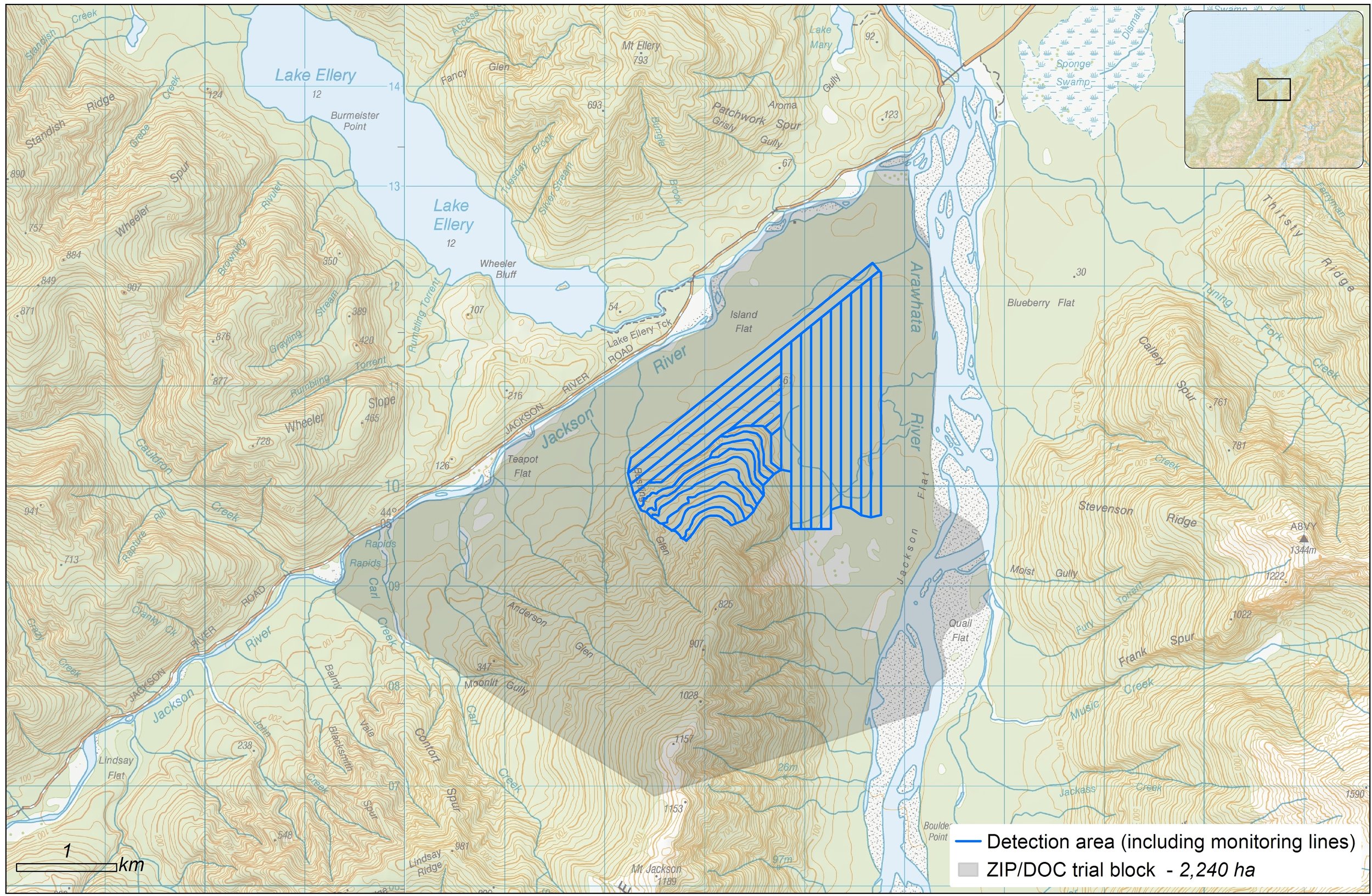ZIP is attempting to develop a modified technique for the aerial application of 1080 to completely remove possums and rats from large mainland areas. If we are successful, and we also successfully develop techniques to prevent possum and rat invaders from re-establishing, then the large-scale repeated application of aerial 1080 may no longer be necessary to protect New Zealand’s biodiversity.
In 2016-17 we worked with the Department of Conservation (DOC) to trial the modified technique at a 1,600 hectare block on Taranaki Mounga (Egmont National Park). The trial is described in our 2016-17 Annual Report (Highlight 1). The results suggested that the modified technique can completely remove possums from a treatment area, and may also be capable of completely removing rats.
Encouraged by that result, and keen to further test and develop this technique, we ran a second trial in 2017 in South Westland. The trial and results are briefly summarised in the video below:
What did we do?
The South Westland trial was carried out on a 2,300 hectare block at the confluence of the Jackson and Arawhata Rivers. Monitoring conducted before the 1080 application suggested that possum density in the block was high (3-7/ha), and rat density was very low (<1/ha).
Prefeed was applied by GPS-guided helicopter over the entire block on 5 June 2017, followed by the second application on 16 June. Prefeed is a non-toxic version of the bait which ‘teaches’ possums and rats that this ‘food’ is safe, so that they more readily consume the toxic bait once applied.
As part of the planning for this project, we were advised that juvenile kea were the non-target species most at risk of consuming toxic bait. Consequently, we contracted a specialist to survey the block for the presence of kea after the prefeed application. No flocks of juvenile kea were observed, with just 5 birds (2 adults, 3 sub-adults) seen.
The 1080 toxic bait was applied by GPS-guided helicopter over the entire block on 5 July 2017. This application was followed by five fine nights, which maximised the likelihood that all possums and rats in the block would be exposed to the toxin.
More details are available here about the modified technique.
A ‘detection area’ of 394 hectares was intensively monitored to assess the performance of the modified technique (assuming it was representative of the entire trial site). The detection area was situated away from the boundaries of the block to maximise the probability that any animals detected were survivors of the operation, rather than animals that had entered the area from outside it.
Map of the trial site, showing the aerial 1080 treatment area and the location of the detection area and monitoring lines within it.
Five days after the toxin was applied, our team deployed 964 tracking tunnels lured with Nutella and 482 chew cards filled with peanut butter throughout the detection area. All of the devices were checked and refreshed weekly, or whenever river conditions allowed access to the detection area.
Twenty days after the toxin application, 97 motion activated cameras were also deployed. The footage recorded was checked weekly.
The detection devices were monitored for 55 days after the application of the toxin, to maximise the probability of detecting any survivors and, if any survivors were detected, to enable a second application of toxin to be applied before they could breed independent young.
The detection team also recorded observations of non-target and target species.
What were the results?
ZIP ranger Nate with a tracking card (showing no rat tracking!)
The 55-day period that the network of detection devices - i.e. tracking tunnels, chew cards and cameras - was monitored provided 83,410 opportunities to detect possums or rats (i.e. the ‘opportunities’ = the sum of the number of days that each device was monitored for).
Over the 55-day period, no rats or possums were detected.
The following non-target species were found dead in the detection area: 1 chaffinch, 1 song thrush, 3 blackbirds, 2 tomtits, and 3 deer. We assume that 1080 caused their deaths, but did not undertake toxin residue testing to confirm this.
The field team recorded 31 instances of seeing or hearing kea within the detection area. The motion activated cameras also recorded 6 live encounters with kea.
In addition, the cameras recorded live encounters with 1 South Island robin, 1 tomtit, 1 kākā, 1 song thrush, 8 blackbirds, and 6 deer.
South Island robin, 28 July 2017
Deer, 19 August 2017
Kaka, 14 August 2017
Kea, 20 August 2017
What did we learn?
The South Westland trial is possibly the first time that aerial application of 1080 has successfully removed all of the possums and rats from an area. The possum numbers prior to the aerial application of 1080 were high and we therefore consider the trial represented a ‘hard test’ of our modified technique. Although the rat numbers were initially very low, the results were nonetheless pleasing.
There was a small number of non-target deaths observed in this trial. However, the non-target animals seen alive on the cameras during the detection period provided strong evidence that the overall impact was very low. It is particularly encouraging that we did not observe any negative impact on kea during the trial.
The Taranaki and South Westland trials have led us to conclude that the modified technique for applying aerial 1080 shows excellent potential to be able to completely remove possums from large areas of predominantly native forest.
We also concluded that the technique shows very good potential to be able to completely remove rats from similar sites.
Acknowledgements
We’d like to thank DOC South Westland staff for their operational support of this trial. Our thanks, too, to the DOC technical advisors for helping us to plan how to minimise the potential impact of the modified technique on non-target species.
Want to learn more?
Check out the technical report.







